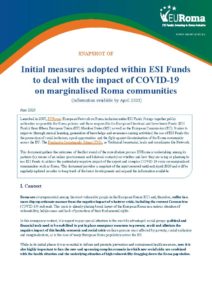The majority of countries covered are already or are planning to develop special measures to address the situation within the framework of ESI Funds and other EU Funds (notably FEAD), complemented in most cases with actions funded by national resources (at national, regional and local level).
 EURoma releases the first outcomes of a consultation process undertaken among its partners[1] on how they are already or they are planning to use European Structural and Investment Funds (ESI Funds) to address the particularly negative impact of the urgent and complex COVID-19 crisis on marginalised communities such as Roma.
EURoma releases the first outcomes of a consultation process undertaken among its partners[1] on how they are already or they are planning to use European Structural and Investment Funds (ESI Funds) to address the particularly negative impact of the urgent and complex COVID-19 crisis on marginalised communities such as Roma.
The document published provides a snapshot of the situation in the initial phases of the crisis (until end of April) and will be regularly updated with the findings of the ongoing EURoma consultation process in order to keep track of the latest developments and expand the information available. While it mainly focuses on the use of ESI Funds, it also includes information related to other EU Funds (notably the Fund for European Aid to the Most Deprived, FEAD) as well as to measures related to funds at national level (national, regional and local).
Context
Roma are overrepresented among the most vulnerable people in the European Union (EU) and, therefore, suffer in a more disproportionate manner from the negative impact of whatever crisis, including the current Coronavirus (COVID-19) outbreak. This crisis has placed broad layers of the European Roma in a serious situation of vulnerability, helplessness and lack of protection of their fundamental rights.
In this emergency context, all political and financial tools need to be mobilised to put in place emergency measures to prevent, avoid and alleviate the negative impact of this health, economic and social crisis on those persons most affected by poverty, social exclusion and marginalisation, as it is the case of many European Roma population across the EU. Their nature and characteristics such as the long-term and large-scale support make ESI Funds key financial instruments to address such complex situations.
The European Commission has called for the mobilisation of EU funds, including ESI Funds, in the different instruments proposed over the past months to tackle the impact of the COVID-19 crisis and has adopted a wide range of measures to promote and facilitate their use. Among them, the Coronavirus Response Investment Initiatives (CRII and CRII+), which introduce extraordinary flexibility to allow full-mobilisation of all non-utilised support from ESI Funds. The emergency temporary recovery instrument ‘Next Generation EU’ also puts forward proposals to provide a swift update to the rules of both the current funding programmes and the 2021-2027 programming period. As part of this instrument, the REACT-EU initiative will make available €55 billion of additional resources to the cohesion policy funds (ESF, ERDF and Cohesion Fund) and to the FEAD in 2020-2022. In addition, important amendments to the European Social Fund Plus (ESF+) proposal are made, as part of the Multiannual Financial Framework (MFF) 2021-2027 tabled on 27 May. Finally, Commissioners Helena Dalli (Equality), Stella Kyriakides (Health and Food Safety) and Nicolas Schmit (Jobs and Social Rights) sent a letter to the relevant Ministers in each Member State emphasising the need for specific measures for vulnerable groups, including Roma, in the context of the COVID-19 crisis.
The European Parliament also approved urgent measures to mitigate the impact of COVID-19, which, following the formal approval by the European Council, were published in the Official Journal on 31 March and entered into force the day after.
Main findings
The majority of countries who took part in the consultation process foresee special measures related to EU funds, in particular ESI Funds, to address the particularly negative impact of COVID-19 on the most vulnerable people, such as Roma.
In some cases, they concern the direct modifications/amendments on the part of ESI Funds beneficiaries (in line with the latest European Commission’s proposals to counter the impact of the crisis); in others the adoption of new measures following the launch of specific calls within ESI Funds programmes. In addition, some partners report measures related to national funding, in combination or not with EU Funds/ESI Funds.
While at the moment of gathering of information corresponded with the initial phases of the crisis and there was still a lot of uncertainty on the measures to be undertaken and/or on specific aspects of their development, some trends can be already observed. Among them:
- The use of mainstream approaches to target Roma, opting for measures open to individuals with needs in general (which in many cases do not even explicitly mention Roma) and territorial approaches, targeting the most deprived areas (settlements) and/or marginalised and socially excluded areas (neighbourhoods). It remains to be seen how countries/OPs using mainstream approaches to target Roma ensure that measures adopted do reach them.
- The predominance of the European Social Fund (ESF) and the Fund for European Aid to the Most Deprived (FEAD), followed by the European Regional Development Fund (ERDF) to a lesser extent.
- The trend to frame the special measures planned with ESF (whether new ones or adaptations) within the same TOs/IPs that were already used to target Roma, whether IP 9 (ii) or others, notably IP 9 (i), with only a few exceptions.
- The intention to use the possibility offered by the EC- Coronavirus Response Investment Initiative (CRII) to cover these measures with unused funds but not the possibility to request the EC for 100% co-funding for these interventions.
- The prevalence of two areas of support: healthcare information and support (primary care…) and distribution of food and basic necessities.
- The predominance of measures with a national territorial dimension (in some cases complemented with measures at regional and/or local level) and a management at national level for EU/ESI Funds.
Now that the worst of the health crisis is over, it is time to fully mobilise ESI Funds and use all their potential to address the serious consequences at the social and economic levels and contribute to the complex recovery ahead of us. The different initiatives adopted by the European Commission over the past months offer numerous possibilities to maximise their potential. In this sense, it is also essential to move from only measures related to health and coverage of basic needs to other areas of support which are key for maintaining and promoting structural changes, such as employment or education.
Further information
For further information, check EURoma Snapshot: how ESI Funds are initially used or planned to be used to address the impact of COVID-19 crisis on Roma
[1] This document gathers the input received from eleven EURoma partner countries (out of fifteen): Belgium, Bulgaria, Croatia, Czech Republic, Finland, Greece, Hungary, Italy, Portugal, Slovakia and Spain.

